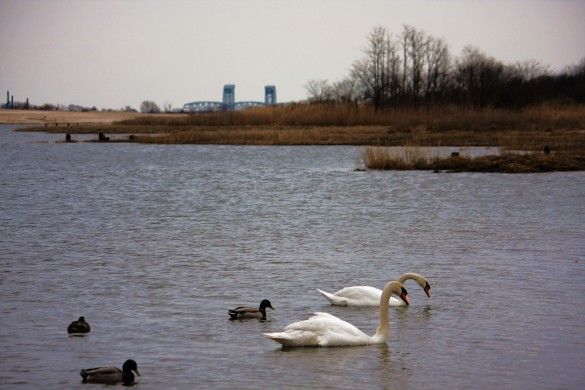Breakdown: The Mute Swan Management Plan That Could See Sheepshead’s Iconic Fowl Finished

We recently published an article announcing New York State’s newest plan to eliminate mute swan, the iconic species the dot the Sheepshead Bay waterfront, from the state. Many of the news reports – including our own – were somewhat vague about the plan, so we read through it and compiled a list of things you should know about the “Management Plan for Mute Swans in New York State” released by the Department of Environmental Conservation. The document can be read in full here.
It may seem like New York State only recently began picking on these swans that have become a part of Sheepshead Bay and other areas. But the state has had its sights on these big white birds since 1993 when the conservation department adopted a mute swan “management policy.” The newest plan only intensifies the state’s efforts to remove mute swans from the whole state by 2025.
Let’s start with why the DEC wants to eliminate mute swans. The overarching concern is that the swans, which are an invasive species brought here from Europe, live a damaging lifestyle that causes harm to the habitat of native species. Here are some of the details mentioned in the report:
- Swans destroy aquatic vegetation
- By eliminating vegetation, swans reduce cover and habitat for native marine life, altering their population balance
- Swans can be aggressive towards people
- Swans are territorial, and displace native wildlife species
- Waste produced by swans can upset the chemical balance of waterways like Sheepshead Bay
Below is a list highlighting “the management strategies” the environmental department plans to implement. We’ve left out some that are unlikely to be implemented locally, like allowing hunters to take swan as game:
- Capture and kill them. This, of course, is the plan that has received the most attention. This plan is simple enough: authorize the DEC to conduct mute swan control on any accessible public or private lands in the state. This plan will be emphasized downstate, in the Lower Hudson Valley and Long Island, and especially near airports – making Sheepshead Bay a prime target. Any swans removed will be euthanized. Nests will be destroyed, and eggs will be oiled or punctured.
- Feeding is bad. User “sadeyes” commented on the last article and wrote that “the problem is not the swans, but the humans who constantly overfeed them,” a sentiment that is similar to the government’s. In the DEC’s plan, they write that part of the mute swan problem is that people provide them “with supplemental feeding,” and the DEC hopes to combat this with a public information campaign, and new laws that prohibit the feeding of swans.
- Prevent flight and sex.At 20 to 25 pounds and a wing span of nearly seven feet, adult mute swans are the biggest bird in the state, according to the DEC. They often migrate and the DEC wants to prevent that by removing a bone in their wings to prevent flight, a process known as pinioning. With over 2,200 swans in the state that they would have to pinion, pinioning seems a little too resource intensive to be used for the majority of the population. They also seek to pursue sterilization, and egg oiling.
- No more selling a swan. The DEC wants to make it illegal for people to sell and buy swans. This goes back to ultimately eliminating wild swans by preventing people from releasing bought mute swans back in the wild.
- Allow for the adoption of free-ranging mute swans. While pursuing a ban on the importation of mute swans, the DEC is also proposing that those who wish to own them obtain a license and capture them from the free-ranging population. Adopted swans would then have to be pinioned or sterilization, and permanent markings.
These strategies are supported by the field research of the New York State Department of Environmental Conservation from 2004-2007. The underlying reasoning is that mute swans live a damaging lifestyle.
Our community seems to have a lot to say about these swans. There are a number of petitions going around, but the best way to be heard on this issue is to directly comment on the plan using the Department of Environmental Conservation’s methods.
Deadline for comments is February 21. You can write to: NYSDEC Bureau of Wildlife, Swan Management Plan, 625 Broadway, Albany, NY 12233-4754 or by e-mail to fwwildlf@gw.dec.state.ny.us (please type “Swan Plan” in the subject line).



